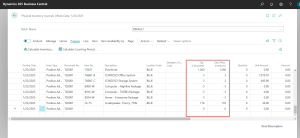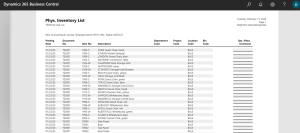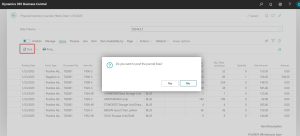Financial accounting regulations require that at least once a year, a company conducts an inventory of its assets and liabilities, typically done at the end of the financial year. Within the inventory process, stocktaking represents the most significant workload. Initially, a physical determination of existing quantities is performed, followed by a comparison of the physical count with the recorded quantities. If discrepancies are found, they need to be introduced and recorded in the system.
To carry out this operation in the ERP Dynamics Business Central system, there is a specific inventory journal called the “Physical Inventory Journal.” This journal can be accessed most easily using the search function within Business Central and searching for the term “physical inventory journals.” However, it’s important to note that in the search results, the first option should be selected, as there is also a physical inventory journal specific to the Warehouse module in Business Central, which is not the subject of the discussion here.
By clicking on the search result, the page for the physical inventory journal will open, resembling a regular stock journal but with a special function accessible from the menu by choosing Prepare-> Calculate Inventory:
By invoking this function, all existing stocks at a certain date and in a certain location are brought into the journal lines. Before generating the journal lines, there is an options box where the posting date, document number, and location for which the physical inventory is to be carried out must be selected.
As can be seen in the image below, in the journal lines, there are two columns, “Quantity (calculated)” and “Quantity (physical inventory).” The first column shows the quantities available in Business Central at the time of inventory (scripted). The second column will contain the quantities resulting from the physical inventory conducted on-site.
To obtain the list necessary for physical inventory, the print function is invoked from the journal lines, resulting in a list to be used by those conducting the inventory.
The actual inventory involves activities such as counting, weighing, measuring, etc., and will result in an inventory list completed with what was physically found at the location. Based on this list, in the physical inventory journal, quantities resulting from inventory will be entered in the “Quantity (physical inventory)” column. If there are differences between the calculated quantities from Business Central and the physically identified quantities, these differences will be reflected in the stock in the system when the lines in the physical inventory journal are posted.
The posting will update the data in Business Central and eliminate the difference between the scripted and on-site records. It’s worth noting that we have complete traceability over the entire physical inventory action. Thus, on one hand, in the system, we have the ledger entries that were generated as a result of posting the differences (positive or negative adjustments) found between the calculated and physical quantities:
But as a result of physical inventory journal posting, we also have specific ledger entries called physical inventory ledger entries, one for each line that was present in the journal.
In this way, we maintain a record of all items that were included in the inventory list, confirming that all items were subject to inventory.
Elian Solutions is part of the Bittnet Group, active for over 15 years as an implementer of the Microsoft Dynamics 365 Business Central ERP system. With a team of over 70 employees and a portfolio of over 250 clients, Elian Solutions is one of the key Microsoft partners for ERP systems.














